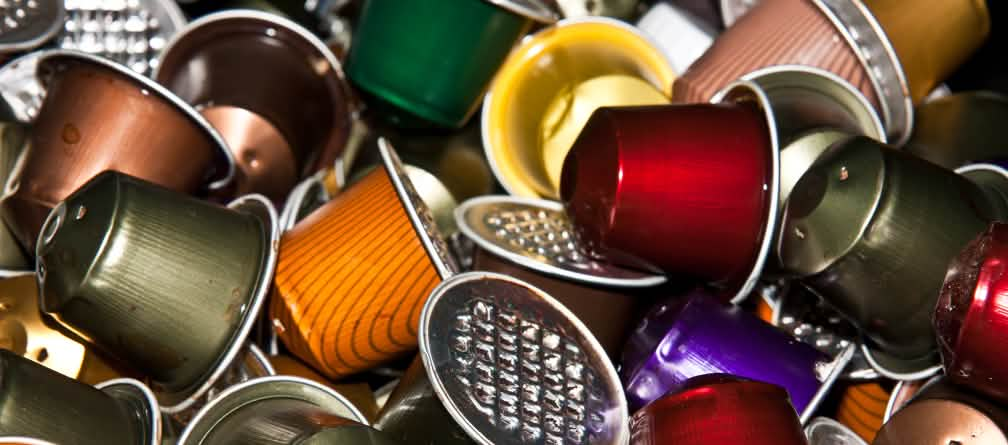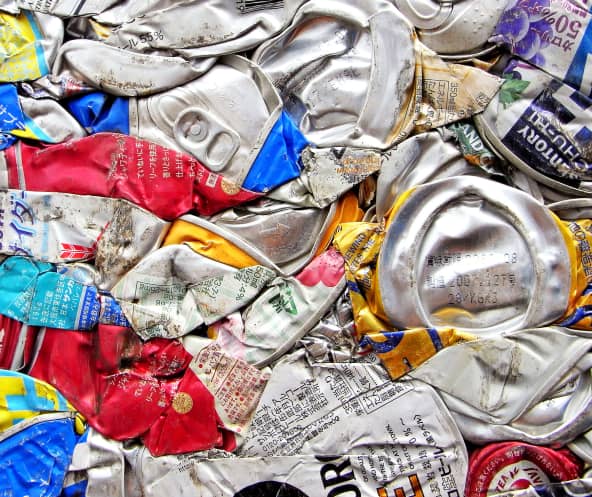
Questions and answers about aluminum
What are aluminum and bauxite?
Aluminum is the third most abundant chemical element in the Earth’s crust, where it occurs in the form of oxides and aluminum silicates. The ore bauxite is the raw material for the production of aluminum.
The main applications for aluminum and its alloys are automotive, construction, mechanical engineering and packaging.
Is rainforest destroyed for aluminum?
Bauxite is usually extracted in open-pit mines. Much of the known bauxite reserves are located in the tropical belt, and rainforest is being cleared for mining in the producing countries of Guinea, Jamaica, India, Australia and Brazil. This often threatens the livelihoods of Indigenous peoples – as in the case of the Niyamgiri Mountains in Orissa, India.
Brazil’s most important bauxite mine, Porto Trombetas, which accounts for 70 percent of Brazil’s total production, is located in the middle of the otherwise pristine Amazon rainforest. Discharging wastewater into nearby Lake Batata left the lake bed covered with several meters of toxic silt, making it one of Brazil’s worst industrial disasters. Today, 100 hectares of forest are cleared each year to make way for the mine, which has been in operation since 1979.
Why is aluminum production dangerous?
Aluminum smelting is also harmful to the environment because of its waste product, toxic red mud. For every ton of aluminum produced, between one and six tons of the hazardous sludge are generated. Since there are few options for processing the red mud, it is stored in large reservoirs or simply dumped into rivers, with disastrous consequences for the ecosystems affected.
The gases produced during the smelting process – especially fluoride – are harmful to plants, wildlife and people living near smelters, causing respiratory illnesses, bone damage (fluorosis), skin problems and many other health risks.
How does aluminum production impact the climate?
Aluminum smelting is very energy-intensive. Producers therefore try to move this production step to countries with low electricity costs. The electricity needed is generated primarily by hydroelectric or coal-fired power plants. Hydropower dams usually lead to further extensive destruction of rainforests and habitats. Dams also contribute to climate change through the methane that forms in their reservoirs as plant debris decomposes underwater. As a result, electricity from the Balbina power plant in Brazil is more climate-damaging than that from a comparable coal-fired power plant. Other greenhouse gases, such as fluorinated hydrocarbons (6,000 to 9,000 times more potent than CO2), are released during smelting.
How is aluminum produced?
At eight percent, aluminum is the third most abundant element in the Earth’s crust. It was first discovered in 1808. However, it was not until 1886 that the process of electrolysis was invented, making it possible to produce the metal economically.
Bauxite, an ore containing up to 60 percent aluminum, is the only economically significant raw material used in its production. In the Bayer process, the mined ore is heated to 150 to 200°C in pressure vessels with caustic soda. The aluminum is dissolved as sodium aluminate in an extraction process. The iron-rich residue, red mud, is filtered off. This caustic substance must be stored as toxic waste. The alumina is melted and reduced to metallic aluminum in an electrolysis process that consumes large amounts of electricity – the production of one million tons of alumina consumes as much energy as half a million households in one year.
What is the environmental impact of “red mud”?
Red mud consists of fine particles of iron compounds that give it its color and the caustic soda used in its production. It also contains many heavy metals, depending on the origin of the bauxite used.
If the sludge is improperly stored – or, as in some countries, simply dumped into nearby rivers – the heavy metals and caustic soda have serious consequences. The fine particles silt up rivers and lakes, killing aquatic plants and animals. Poorly sealed ponds contaminate groundwater with heavy metals, posing a long-term health risk to people living nearby.
In October 2010, a serious accident involving red mud occurred in Hungary: The dam of a reservoir burst, flooding the surrounding area with approximately one million cubic meters of sludge. The wave of red mud hit several villages, killing ten people, injuring 150 and destroying numerous homes. The sludge flowed through a tributary into the Danube, causing serious damage to the flora and fauna of the affected waters.
What does Brazil’s Belo Monte dam have to do with my packed lunch?
The Belo Monte dam in northern Brazil is a gigantic hydroelectric project on the Xingu River. The dam will create a reservoir of 600 square kilometers – about the size of Lake Constance. Between 20,000 and 40,000 people will be displaced by the dam. The livelihoods of 18 different ethnic groups living along and from the river could be destroyed. Uncontacted Indigenous people living in the region are particularly vulnerable: Construction will bring a massive influx of outsiders, bringing diseases to which the Indigenous people have no antibodies.
With a capacity of 11 gigawatts, Belo Monte is said to be the fourth largest power plant in the world. Most of the electricity it generates is destined for Brazil’s energy-intensive export industry. In particular, aluminum producers in the north of the country will use the “cheap” and “climate-friendly” electricity from the hydroelectric plant. The impact of the aluminum foil that wraps your sandwich can be felt deep in the Amazon rainforest. A reusable sandwich box is a much better solution.
What other everyday products contain aluminum?
In addition to the obvious foil, aluminum is hidden in many other everyday products. It can be found in the packaging of chewing gum, chocolate bars, coffee, Tetra Paks, yogurt lids, toothpaste tubes, deodorant and soda cans, and even in the lids of glass bottles.
It is important to avoid this type of packaging whenever possible – and if it is unavoidable, to place it in the appropriate bin, as aluminum can be recycled indefinitely. The production of “secondary” aluminum requires only five percent of the energy used to produce new aluminum.
However, it is difficult to recover the aluminum in composite packaging (coffee packaging or Tetra Paks) in the recycling process. Today, this waste is either used in cement production or incinerated.
Aluminum is used in household goods, such as cooking appliances, because of its good thermal conductivity, and in home construction, such as windows. It is also used in large quantities in airplanes, railroad cars, automobiles and power lines because of its light weight. In the electronics industry, aluminum is increasingly being used to replace copper. The rapid expansion of solar power generation is also leading to increased production of aluminum mounting systems.
How much aluminum do we actually use in industrialized countries?
Because of its low density – there are only three lighter metals – aluminum is playing a growing role in industry today. Consumption of the metal continues to rise in industrialized countries. In terms of per capita consumption, Germany leads with 31.6 kg per person per year, followed by the United States (30 kg) and Japan (26.4 kg).
Transportation accounts for the largest share of global aluminum use (20 percent), followed by construction (22 percent), packaging (15 percent), power generation (12 percent), as well as mechanical engineering and consumer durables (9 percent each).
Who is responsible for bauxite mining and aluminum production?
The major bauxite producing countries are Australia (30 percent of total production in 2011), China (20.9 percent), Brazil (14 percent), Guinea (8 percent), India (9 percent), and Jamaica (5 percent). Other less significant deposits are found in the United States and Europe. Guinea is currently believed to have the largest reserves at 7.4 billion tons (US Geological Survey 2012). The major aluminum companies are predominantly based in the developed world. Together they control nearly 50 percent of global production, led by RUSAL (Russia), followed by Alcoa (USA), Rio Tinto Alcan (Canada), Chalco (China) and Norsk Hydro (Norway). Source: Reuters
Is there such a thing as “clean” aluminum?
The cleanest aluminum is the aluminum that is not produced in the first place. Any packaging material that is avoided reduces the environmental impact. If use is unavoidable, it should be recycled through appropriate disposal systems.
There are also less harmful way to produce aluminum, such as at an aluminum plant near Hamburg, Germany. The aim there is to reduce energy consumption as much as possible. The red mud produced at the plant is cleaned of caustic soda, which is recycled. The remaining waste is then stored in a sealed container. This minimizes the environmental impact of production.
However, issues such as the environmental degradation of bauxite mining and the climate impact of transporting the ore to Germany remain unresolved.
Isn’t aluminum an important source of foreign exchange and a driver of development for the producing countries?
In most cases, the projects initially create mountains of debt, with money flowing to the rich countries for years in the form of interest payments. Not only is the initial investment in the mines largely paid for by the state in order to attract foreign companies, but the required hydroelectric plants are also paid for by the state. In Brazil, aluminum producers have collectively negotiated contracts with the state-owned power company. As a result, they buy electricity at less than the cost of generating it. Other benefits, such as tax exemptions, duty-free imports of inputs, and income tax exemptions for foreign employees, are designed to attract companies, according to the governments.
For the local population, however, the projects often cause major social and environmental problems while creating very few jobs. The example of the Turucuí dam shows that the population hardly benefits. Despite the presence of the hydroelectric plant, some of the surrounding communities are still not connected to the electricity grid. The bauxite mined and the aluminum produced are mainly destined for export.
What can I do?
- Avoid using aluminum foil. Use sandwich containers.
- When grilling, use stainless steel trays that can be reused and eliminate the need for aluminum foil.
- Reusable bottles are an alternative to canned beverages.
- Avoid buying single-serving jams, honey, or coffee creamer. Drugstore samples often come in aluminum-coated packaging.
- Buy condiments such as mustard in jars instead of tubes.
- Buy organic coffee – preferably from a small roaster – instead of using pods. This not only reduces aluminum use and protects the rainforest, but also saves you money. You may also be able to persuade your roaster to use non-aluminum packaging instead of composite packaging.
- If you cannot avoid using aluminum products, make sure the aluminum is disposed of properly in the recycling bin.
- If you are renovating your home, consider installing wood-framed windows – made from non-tropical woods, of course – instead of aluminum.
- When buying deodorant, choose a product that does not contain aluminum. Also check the packaging.
- Ask manufacturers who use aluminum packaging to switch to alternative materials.
- Support Rainforest Rescue’s work to protect forests from being destroyed for aluminum production.
- Educate your family and friends about the impact of aluminum on the rainforest.

